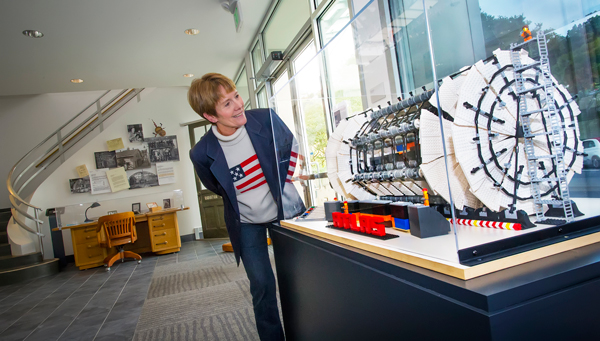The ATLAS experiment at CERN’s Large Hadron Collider, for which Berkeley Lab scientists and engineers provided crucial elements of the inner detector and other key contributions, has joined Ernest Lawrence’s desk and other Lab milestones in the “museum” display in the lobby of Building 50, the Lab’s administration building.
Well, not the ATLAS experiment exactly, but a one-fiftieth scale model of it made entirely from LEGO plastic bricks. The model’s prototype was engineered by Sascha Mehlhase of the Neils Bohr Institute, who was supported and encouraged by the ATLAS Collaboration’s then-Education and Outreach Coordinator, Michael Barnett. Working with LEGO software, the 3-D design took Mehlhase 48 hours, with another 33 hours for assembly. His model has subsequently been replicated at CERN and at institutions in Australia, Canada, and Italy. “So it was natural then to want a model here at Berkeley Lab,” says Barnett.
Early on it became apparent that the Building 50 lobby was the perfect place for the model, and the approach of last October’s “Adventures in Science” Open House gave the project extra impetus. Barnett asked Sourabh Dube to recruit Physics Division volunteers and oversee the assembly. Working with Dube, Mike Hance, Bertha Heimel, and Martina Hurwitz put the model together, and Engineering’s Ken Wilson built a case for its display, with an assist from Steve Dardin.
Heimel, who with Dube spent the most time on construction, says, “Assembling the barrel was complicated, but the barrel holds together very well. The further you got, the more unstable the model became. All the muon wheels, two on each side, are very unstable.”
This proved a challenge in rolling the model to the Bevatron site for Open House. The fragile muon wheels (detectors designed to capture muons, “heavy electron” products of the LHC’s energetic proton collisions) fell apart and had to be reconstructed. Nevertheless, Dube says, “The Open House debut was most successful, and lots of people took interest – even to the extent of asking as to how they could go about building a model for themselves.”
Unfortunately there’s no kit and no instruction manual. However, at http://atlas-model.mehlhase.info/ there is a parts list and a set of videos, underwritten by the ATLAS Collaboration, showing every step in the assembly process.
Early in November an opportunity arose to display the model at a social event, sponsored by swissnex San Francisco, featuring long-time ATLAS spokesperson Peter Jenni and celebrating last July’s discovery of the Higgs boson (or, to be precise, a “Higgs-like” boson). Under Heimel’s direction, the model’s muon wheels were disassembled in advance, and extra padding and a foam cushion were supplied for the trip via SUV across the Bay Bridge.
Heimel says, “I was most worried whether the barrel part would be damaged during transportation. This would not have been easy to fix in a short time, so I took my laptop with the construction video.” Working from videos was a nerve-wracking prospect because, she says, “You cannot really see which bricks are being used and where exactly they have to be put.”
Nevertheless Heimel successfully reassembled the model for the swissnex party (see photos at http://www.flickr.com/photos/ swissnexsanfrancisco/sets/72157632020880566/), and the following day she performed the whole job again. The barrel survived the round trip intact, and the model is now resting in the location originally planned for it, the Building 50 lobby.
